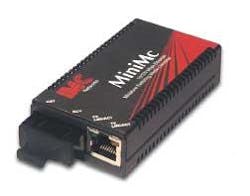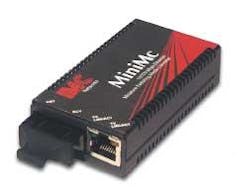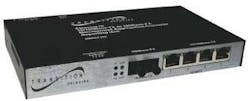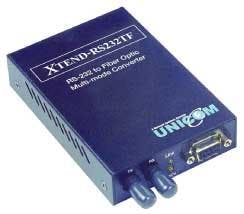For years, media converters have been a cost-effective means of extending the distance of copper-based networks. Although the most common media converters are still copper-to-fiber, today we're seeing several new converters designed to accommodate almost any application, speed, and protocol for both inside and outside the LAN.
null
With Ethernet protocol migrating outside the LAN to metro access protocol for service providers, media converters are becoming more complex and feature-packed. Media converters cover a huge range of devices (see table, page 46), from basic standalone, up to rack-mountable types with simple network management protocol (SNMP) capabilities for monitoring link status information.
A common task at hand
Whether it's conversion from10 Mbits/sec, 100 Mbits/sec, or Gigabit UTP to multimode or singlemode fiber, copper-to-fiber media converters have the same task in common. "Standalone copper-to-fiber converters are pretty simple, and they're all made with off-the-shelf standard components that take in electrical and spit out optical," says Jukka Rissanen, director of marketing for IMC Networks (www.imcnetworks.com). Recent trends in standalone copper-to-fiber converters include easier installation and use, reduced price, and expanded troubleshooting features.
Although many companies are stepping up efforts to offer Gigabit converters, the highest demand is still for 10 and 100 Mbits/sec. "When you're talking about Gig, it's a whole different class of equipment," says Lance Rasmussen, sales and marketing manager, Red Hawk/CDT (www.red-hawk.com). "For 10 and 100Base-T networks, the media converter is a price-driven sale—it's less expensive to buy a copper switch and use media converters." Red Hawk's BL-270 series converts 10 Mbits/sec UTP to multimode fiber, while the BL-5270 series converts 100 Mbits/sec. Seven diagnostic LEDs provide performance information, including link status, activity, power, and link fail for both the UTP and fiber sides. "For a location where the internal wiring is all fiber, it's cheaper and easier to use a media converter at the workstation rather than installing NICs with fiber connections," says Rasmussen. "Where a media converter might add about $150, a fiber NIC can cost nearly two times that."
IMC Network's new MiniMc 10/100 switching media converter features 10/100 auto-negotiation, making it both a media and a speed converter for flexible use. "We're targeting the MiniMc for low-cost conversion inside or outside the LAN, including campus network and last-mile applications," says Rissanen. "We based the design of the MiniMc on switch technology enabling the connection of both 10 Mbits/sec or 100 Mbits/sec copper to 100 Mbits/sec fiber." According to Rissanen, the compact MiniMc is the first U.S.-made 100 Mbits/sec converter to break the $100 street price barrier.
Following the trends, Metrobility Optical Systems (www.metrobility.com) recently introduced the Delta Class Twister, a lightweight, durable standalone media converter with a sleek design. "It's not just a pretty face," says Metrobility CEO Alex Saunders. Troubleshooting LEDs include link loss, auto-recovery, far-end fault, and remote loopback. Available for both 10/100 and 100 Mbits/sec to multimode or singlemode fiber, the Delta Class offers built-in cable management for routing cables, and protection of connectors.
Application, application, application
null
T-1/E-1/J-1 media converters extend 1.544 Mbits/sec T-1/J-1 and 2.048 Mbits/sec E-1 copper-based circuits over optical fiber. Some include only a T-1/E-1 or only a J-1 connection, while others include dipswitches for choosing between the two rates. "The service point of entry may not be where you need it, and T-1/E-1/-J-1 converters can extend the circuit through a building or campus," says Rissanen of IMC. "Some people also use them to extend PBX switches." The T-1/E-1/J-1 converter series from IMC Networks supports fiber distances up to 80 km, includes built-in jitter removal, line integrity testing, diagnostic tools, and remote management features.
Another new technology is dual wavelength, single-strand fiber media converters. "Single-strand fiber technology doubles the capacity of an optical network, which is beneficial for any application where fiber is in short supply or expensive," explains Rissanen. "Usually, one strand of fiber is used for outgoing data and another for incoming, but the new single-strand fiber converters allow the transmission of two-channel, full-duplex data on just one strand of fiber, doubling the amount of potential customers."
Unicom (www.unicomlink.com) offers standalone RS-232 and RS-422/485-to-fiber converters for extending serial protocol over fiber—ideal for connecting older equipment located at a remote location. Early this year, Unicom plans to introduce a proprietary, software-driven RS-232-to-10/100 Ethernet converter, which will convert both media and protocol—not just extend it. "In industrial environments, manufacturers do not want to scrap expensive equipment," says Salvador Lara, Unicom marketing communications manager. "The RS-232-to-10/100 Ethernet converter will allow them to migrate their equipment to run on their 10/100 Ethernet network."
Fiber-to-fiber converters are ideal for extending within the LAN or outside to other buildings. "Multimode is short distance fiber and often installed for cost reasons, whereas singlemode is used for longer distances of 80 km or more," says Rissanen. "A multimode-to-singlemode converter can be used to connect two multimode fiber backbone sites, such as in a campus-type environment." IMC's S2MM and FiberWay series fiber-to-fiber mode converters are protocol-independent to include data rates ranging from Ethernet, Fast Ethernet, ATM/OC-3, and OC-12 to Gigabit Ethernet.
The management advantage
Managed media conversion is essential for metro access applications, such as connecting servers to a Gigabit backbone. "We're seeing a common thread of people wanting to manage the remote end from their central office, because they are either a service provider or they don't have someone at the remote end who can troubleshoot," says Bill Schultz, vice president of marketing, Transition Networks (www.transition.com). Most managed media conversion systems use SNMP management software applications that let network managers configure, monitor, and manage their physical layer networks, as well as enable or disable ports. Basically, SNMP alerts to possible network failures by reporting port status, link loss, and faults, as well as environmental information such as voltage and temperature.
null
Transition's new Management Aggregation Converter (MAC) is billed as a cost-effective means of managing the remote end. The MAC consists of a management unit and reporting unit. "One management unit can support up to 15 reporting units," says Schultz. "Having one main management unit aggregating the information from the reporting units keeps cost down for users." Each reporting unit is programmed to communicate with the main management unit (managed via SNMP software), which can also send configuration instructions to the reporting unit to change features, such as forcing 10 Mbits/sec or 100 Mbits/sec on a link. "The MAC's main management unit can be placed anywhere on the network, letting administrators isolate problems from one location," explains Schultz.
IMC Network's iMediaCenter series is a chassis-based system that includes an SNMP agent embedded directly on the chassis backplane. "With the SNMP built in, there is no additional management cost to the user, and no need to purchase, install, and configure separate management modules," says Rissanen." IMC Networks' cross-platform network management application provides operational and system health information, as well as the ability to control various functions of the entire system. iMediaCenter has slot configurations for conversion modules, including 10 Mbits/sec, 100 Mbits/sec, Gigabit, ATM copper-to-fiber, and protocol-independent fiber-to-fiber.
Metrobility's Radiance R5000 Central Service Platform, installed at a central office or point-of-presence (POP), uses Interface Line Cards for various applications, speeds, and protocols, including redundant interface line cards for continuous availability. "The R5000 with redundant interface line cards are used for mission-critical networks like the New York Stock Exchange where dual paths are required to prevent workstation failure," says Saunders. "We also see them being used in news rooms where video feed must be constant." Metrobility's Radiance platform sends commands and collects information in real time, because it features a patented reporting capability that is not dependent on SNMP polling time, and does not require any user bandwidth.
More sophistication
Although some have dubbed media converters ad hoc with a limited lifetime, most industry professionals believe these devices will be around for several decades. "Media converters will not go away as long as we have copper," says Lara of Unicom. "Decades down the road, if we do go to all fiber, we'll still need media converters. Without them, we'd lose the flexibility needed for connecting various types of infrastructures and equipment within a network."
Betsy Ziobron is a freelance writer covering the cabling industry.
Click here to download "PRODUCT UPDATE: MEDIA CONVERTERS" product table pdf {pdf size=456 K}





